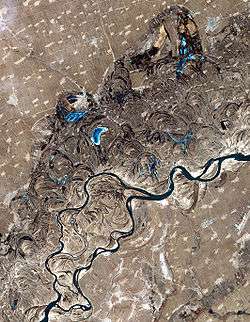Songhua River
The Songhua River (also Haixi or Xingal, Russian: Сунгари Sungari) is one of the primary rivers of China, and the longest tributary of the Amur. It flows about 1,434 kilometres (891 mi) from the Changbai Mountains on the China–North Korea border through China's northeastern Jilin and Heilongjiang provinces.
| Songhua River | |
|---|---|
 Songhua River, just west of Harbin. Oxbow lakes are common sights along the sides of the river. | |
| Native name | Native Name: ᠰᡠᠩᡤᠠᡵᡳ ᡠᠯᠠ (sunggari ula) |
| Location | |
| Country | People's Republic of China |
| Provinces | Jilin, Heilongjiang |
| Physical characteristics | |
| Mouth | Amur |
• location | Tongjiang, Heilongjiang |
• coordinates | 47.699°N 132.5176°E |
| Basin features | |
| Progression | Amur→ Sea of Okhotsk |
| Songhua River | |||||||
|---|---|---|---|---|---|---|---|
Songhua River is shown in a darkish blue color. | |||||||
| Chinese name | |||||||
| Chinese | 松花江 | ||||||
| |||||||
| Alternative Chinese name | |||||||
| Chinese | 海西 | ||||||
| |||||||
| Manchu name | |||||||
| Manchu script | ᠰᡠᠩᡤᠠᡵᡳ ᡠᠯᠠ | ||||||
| Romanization | sunggari ula | ||||||
The river drains 557,180 square kilometres (215,130 sq mi) of land,[1][2] and has an annual discharge of 2,463 cubic metres per second (87,000 cu ft/s).[3]
The extreme flatness of the Northeast China Plain has caused the river to meander over time, filling the wide plain with oxbow lakes, as remnants of the previous paths of the river.
Geography
The Songhua rises south of Heaven Lake, near the China-North Korea border.
From there it flows north, to be interrupted by the Baishan, Hongshi and Fengman hydroelectric dams. The Fengman Dam forms a lake that stretches for 62 kilometres (39 mi). Below the dam, the Second Songhua flows north through Jilin, then northwest until it is joined by its largest tributary, the Nen River, near Da'an, to create the Songhua proper.
The Songhua turns east through Harbin, and after the city, it is joined from the south by the Ashi River, and then by the Hulan River from the north.
A new dam was constructed in 2007 near Bayan (50 km north-east of Harbin), creating the Dadingshan Reservoir,[4] which is named after the scenic area on the south bank (Chinese: 大顶山; pinyin: Dàdǐng Shān; lit.: 'Big Topped Mountain').
The river flows onward through Jiamusi and south of the Lesser Xing'an Range, to eventually join the Amur at Tongjiang, Heilongjiang.
The river freezes from late November until March. It has its highest flows when the mountain snow melts during the spring thaw. The river is navigable up to Harbin by medium-sized ships. Smaller craft can navigate the Songhua up to Jilin and the Nen River up to Qiqihar.
Cities along the river include:
History
In November 2005, the river was contaminated with benzene, leading to a shutdown of Harbin's water supply.[5] The spill stretched 80 kilometres (50 mi) and eventually reached the Amur (Heilong) River on the China–Russia border.[6] On July 28, 2010, several thousand barrels from two chemical plants in China's Jilin City were washed away by floods. Some of them contained 170 kilograms (370 lb) of explosive material like trimethylsilyl chloride and hexamethyldisiloxane.[7][8] In 2016, the part near the city of Jilin was affected by a minor flood.
See also
- Geography of China
- Mudanjiang River
- "On Songhua River", a Chinese patriotic song
References
- ), National Geographic Society (U.S (2008). National Geographic Atlas of China, p. 36. ISBN 9781426201363.CS1 maint: numeric names: authors list (link)
- Amur river basin at Rivers Network
- National Conditions: Main Rivers accessed October 21, 2010.
- "Dadingzishan reservoir – will it have a happy future?". Transrivers. China Daily. 2012-04-10. Retrieved 2019-10-17.
- "Water pollution in China alarming, CCTV.com".
- China By Organisation for Economic Co-operation and Development, p.245. 2007. ISBN 9789264031159.
- Khabarovsk Region prevents poisoned Sungari water from reaching Amur, Jul 30, 2010, Moscow Time
- (in Russian)Defence lines were opened in attempt to intercept the barrels with chemicals, RIA Novosti, 30.07.2010
External links
| Wikimedia Commons has media related to Songhua River. |